ENISA Big Data Threats Report
VerifiedAdded on 2019/11/20
|12
|3688
|260
Report
AI Summary
This report examines the significant threats to Big Data security as highlighted by ENISA. It delves into various security vulnerabilities, including insufficient web application security (authentication issues, web shells, SQL injection), and identifies key threat agents like cybercriminals. The report also explores strategies for mitigating these risks, focusing on improvements to ETL processes (batch processing, join optimization, index management) and the importance of robust IT security measures. The overall conclusion emphasizes the need for a unified, proactive approach to Big Data security, involving collaboration between ENISA member states, technological advancements, and comprehensive staff training to combat the evolving landscape of cyber threats.

Running head: ENISA BIG DATA THREATS 1
ENISA Big Data Threat
Name
Institution
Professor
Course
Date
ENISA Big Data Threat
Name
Institution
Professor
Course
Date
Paraphrase This Document
Need a fresh take? Get an instant paraphrase of this document with our AI Paraphraser
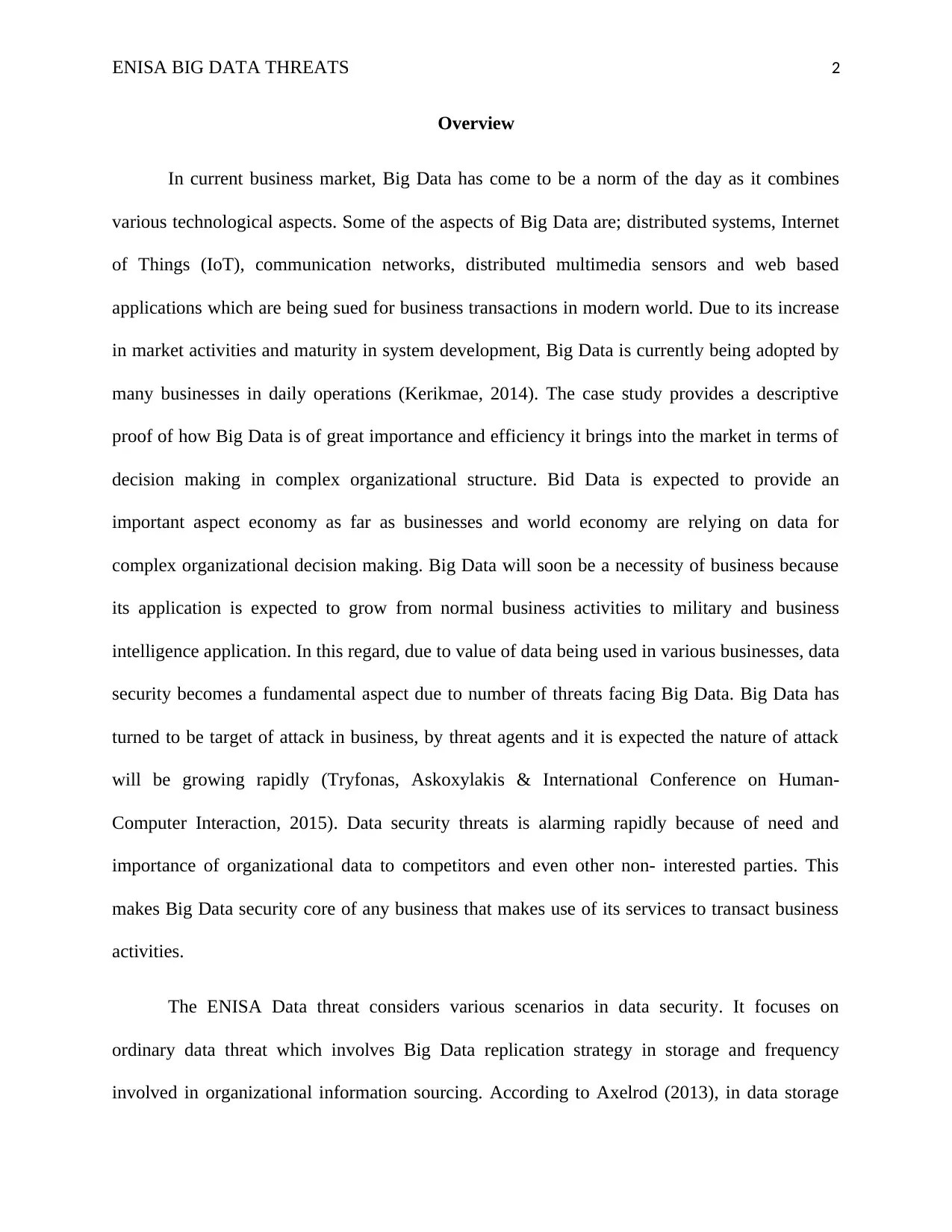
ENISA BIG DATA THREATS 2
Overview
In current business market, Big Data has come to be a norm of the day as it combines
various technological aspects. Some of the aspects of Big Data are; distributed systems, Internet
of Things (IoT), communication networks, distributed multimedia sensors and web based
applications which are being sued for business transactions in modern world. Due to its increase
in market activities and maturity in system development, Big Data is currently being adopted by
many businesses in daily operations (Kerikmae, 2014). The case study provides a descriptive
proof of how Big Data is of great importance and efficiency it brings into the market in terms of
decision making in complex organizational structure. Bid Data is expected to provide an
important aspect economy as far as businesses and world economy are relying on data for
complex organizational decision making. Big Data will soon be a necessity of business because
its application is expected to grow from normal business activities to military and business
intelligence application. In this regard, due to value of data being used in various businesses, data
security becomes a fundamental aspect due to number of threats facing Big Data. Big Data has
turned to be target of attack in business, by threat agents and it is expected the nature of attack
will be growing rapidly (Tryfonas, Askoxylakis & International Conference on Human-
Computer Interaction, 2015). Data security threats is alarming rapidly because of need and
importance of organizational data to competitors and even other non- interested parties. This
makes Big Data security core of any business that makes use of its services to transact business
activities.
The ENISA Data threat considers various scenarios in data security. It focuses on
ordinary data threat which involves Big Data replication strategy in storage and frequency
involved in organizational information sourcing. According to Axelrod (2013), in data storage
Overview
In current business market, Big Data has come to be a norm of the day as it combines
various technological aspects. Some of the aspects of Big Data are; distributed systems, Internet
of Things (IoT), communication networks, distributed multimedia sensors and web based
applications which are being sued for business transactions in modern world. Due to its increase
in market activities and maturity in system development, Big Data is currently being adopted by
many businesses in daily operations (Kerikmae, 2014). The case study provides a descriptive
proof of how Big Data is of great importance and efficiency it brings into the market in terms of
decision making in complex organizational structure. Bid Data is expected to provide an
important aspect economy as far as businesses and world economy are relying on data for
complex organizational decision making. Big Data will soon be a necessity of business because
its application is expected to grow from normal business activities to military and business
intelligence application. In this regard, due to value of data being used in various businesses, data
security becomes a fundamental aspect due to number of threats facing Big Data. Big Data has
turned to be target of attack in business, by threat agents and it is expected the nature of attack
will be growing rapidly (Tryfonas, Askoxylakis & International Conference on Human-
Computer Interaction, 2015). Data security threats is alarming rapidly because of need and
importance of organizational data to competitors and even other non- interested parties. This
makes Big Data security core of any business that makes use of its services to transact business
activities.
The ENISA Data threat considers various scenarios in data security. It focuses on
ordinary data threat which involves Big Data replication strategy in storage and frequency
involved in organizational information sourcing. According to Axelrod (2013), in data storage
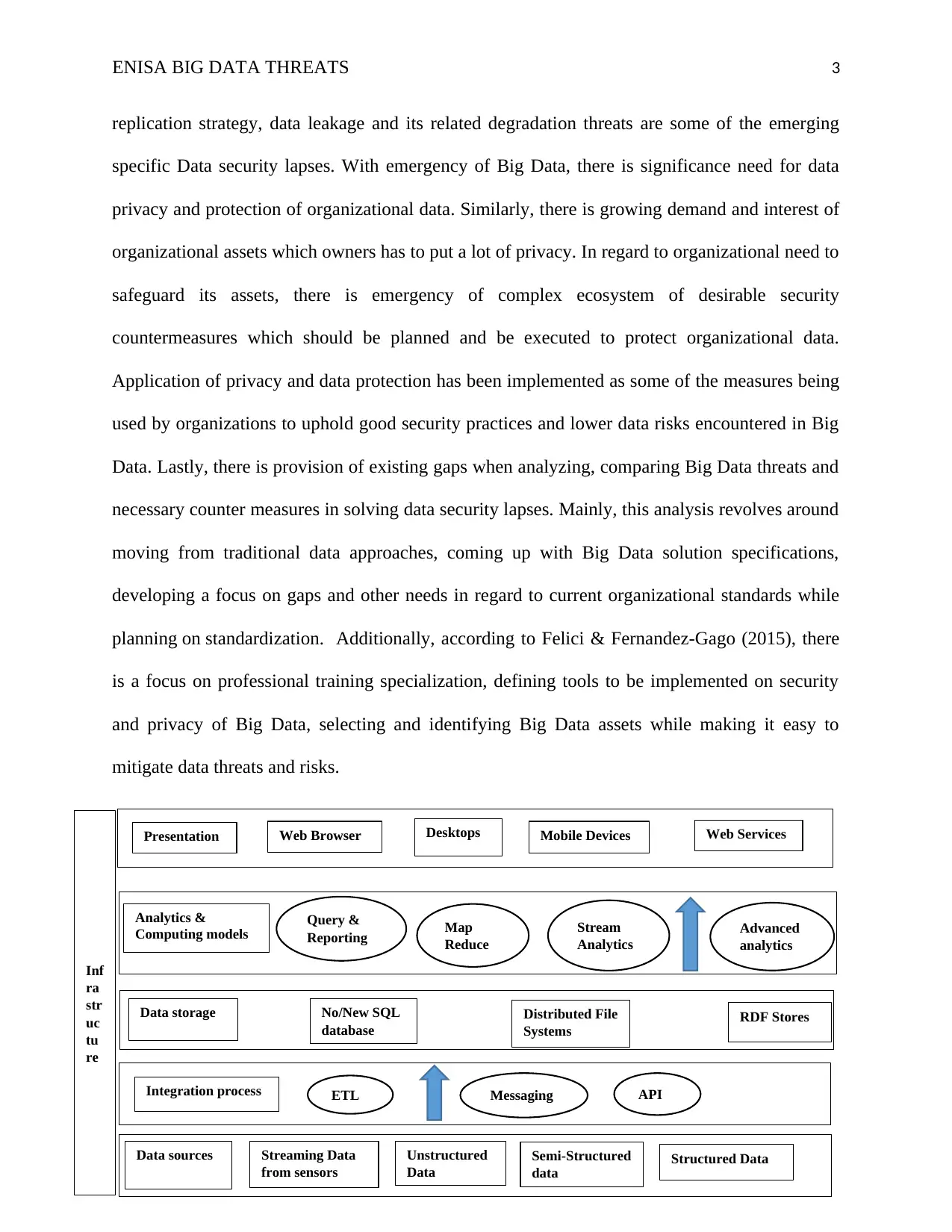
ENISA BIG DATA THREATS 3
replication strategy, data leakage and its related degradation threats are some of the emerging
specific Data security lapses. With emergency of Big Data, there is significance need for data
privacy and protection of organizational data. Similarly, there is growing demand and interest of
organizational assets which owners has to put a lot of privacy. In regard to organizational need to
safeguard its assets, there is emergency of complex ecosystem of desirable security
countermeasures which should be planned and be executed to protect organizational data.
Application of privacy and data protection has been implemented as some of the measures being
used by organizations to uphold good security practices and lower data risks encountered in Big
Data. Lastly, there is provision of existing gaps when analyzing, comparing Big Data threats and
necessary counter measures in solving data security lapses. Mainly, this analysis revolves around
moving from traditional data approaches, coming up with Big Data solution specifications,
developing a focus on gaps and other needs in regard to current organizational standards while
planning on standardization. Additionally, according to Felici & Fernandez-Gago (2015), there
is a focus on professional training specialization, defining tools to be implemented on security
and privacy of Big Data, selecting and identifying Big Data assets while making it easy to
mitigate data threats and risks.
Structured DataSemi-Structured
data
Unstructured
Data
Streaming Data
from sensors
Data sources
Inf
ra
str
uc
tu
re
APIMessagingETLIntegration process
RDF StoresDistributed File
Systems
No/New SQL
database
Data storage
Advanced
analytics
Stream
Analytics
Map
Reduce
Query &
Reporting
Analytics &
Computing models
Web ServicesMobile DevicesDesktopsWeb BrowserPresentation
replication strategy, data leakage and its related degradation threats are some of the emerging
specific Data security lapses. With emergency of Big Data, there is significance need for data
privacy and protection of organizational data. Similarly, there is growing demand and interest of
organizational assets which owners has to put a lot of privacy. In regard to organizational need to
safeguard its assets, there is emergency of complex ecosystem of desirable security
countermeasures which should be planned and be executed to protect organizational data.
Application of privacy and data protection has been implemented as some of the measures being
used by organizations to uphold good security practices and lower data risks encountered in Big
Data. Lastly, there is provision of existing gaps when analyzing, comparing Big Data threats and
necessary counter measures in solving data security lapses. Mainly, this analysis revolves around
moving from traditional data approaches, coming up with Big Data solution specifications,
developing a focus on gaps and other needs in regard to current organizational standards while
planning on standardization. Additionally, according to Felici & Fernandez-Gago (2015), there
is a focus on professional training specialization, defining tools to be implemented on security
and privacy of Big Data, selecting and identifying Big Data assets while making it easy to
mitigate data threats and risks.
Structured DataSemi-Structured
data
Unstructured
Data
Streaming Data
from sensors
Data sources
Inf
ra
str
uc
tu
re
APIMessagingETLIntegration process
RDF StoresDistributed File
Systems
No/New SQL
database
Data storage
Advanced
analytics
Stream
Analytics
Map
Reduce
Query &
Reporting
Analytics &
Computing models
Web ServicesMobile DevicesDesktopsWeb BrowserPresentation
⊘ This is a preview!⊘
Do you want full access?
Subscribe today to unlock all pages.

Trusted by 1+ million students worldwide

ENISA BIG DATA THREATS 4
Insufficient Web Application Security
Holding to the fact that most of organizations rely on various applications to contact or
interface with their customers, data security has become one of the challenging issue
(KORSTANJE, 2017). Each application need to be secured in order to make all transactions
secure and safe. In regard to Big data security, organizations has to make sure all transactions are
secure and data collected from customers is free from manipulation and transactions are real and
free from manipulation. Some of attacks that are prone to data include; insufficient
authentication occurs when organizational website allows attackers to have access to very
sensitive functionality and content without being authenticated by the system in the right manner.
A good example of the system that has been permitting users without undergoing proper
authentication procedures. ENISA Big Data threat on authentication procedures has to follow the
due procedure in regard to available online data resources. Proper authentication procedures
stipulates that, any web application should not give direct access to Big Data infrastructure
without requesting proper user identity. To facilitate complete authentication procedures,
websites and other applications which are used by organization to transact and communicate
with customers should involve location hiding (Lepofsky, 2014). This makes it possible to
protect users’ point of operations. To ensure maximum security of the system, ENISA
recommends that, system should hide their specific locations in which they are operating from.
Consequently, Web shell where its functionality is based on scripts which is uploaded on
webservers to facilitate remote user authentication and administrative checks as it provides
organizational internal operations. Generally, web-shell is described as malicious scripts which
are used by attackers targeting websites that escalates continuous access to any web application
that has been attacked (Harwood, 2015). In regard to persistent system remote access, web shell
Insufficient Web Application Security
Holding to the fact that most of organizations rely on various applications to contact or
interface with their customers, data security has become one of the challenging issue
(KORSTANJE, 2017). Each application need to be secured in order to make all transactions
secure and safe. In regard to Big data security, organizations has to make sure all transactions are
secure and data collected from customers is free from manipulation and transactions are real and
free from manipulation. Some of attacks that are prone to data include; insufficient
authentication occurs when organizational website allows attackers to have access to very
sensitive functionality and content without being authenticated by the system in the right manner.
A good example of the system that has been permitting users without undergoing proper
authentication procedures. ENISA Big Data threat on authentication procedures has to follow the
due procedure in regard to available online data resources. Proper authentication procedures
stipulates that, any web application should not give direct access to Big Data infrastructure
without requesting proper user identity. To facilitate complete authentication procedures,
websites and other applications which are used by organization to transact and communicate
with customers should involve location hiding (Lepofsky, 2014). This makes it possible to
protect users’ point of operations. To ensure maximum security of the system, ENISA
recommends that, system should hide their specific locations in which they are operating from.
Consequently, Web shell where its functionality is based on scripts which is uploaded on
webservers to facilitate remote user authentication and administrative checks as it provides
organizational internal operations. Generally, web-shell is described as malicious scripts which
are used by attackers targeting websites that escalates continuous access to any web application
that has been attacked (Harwood, 2015). In regard to persistent system remote access, web shell
Paraphrase This Document
Need a fresh take? Get an instant paraphrase of this document with our AI Paraphraser
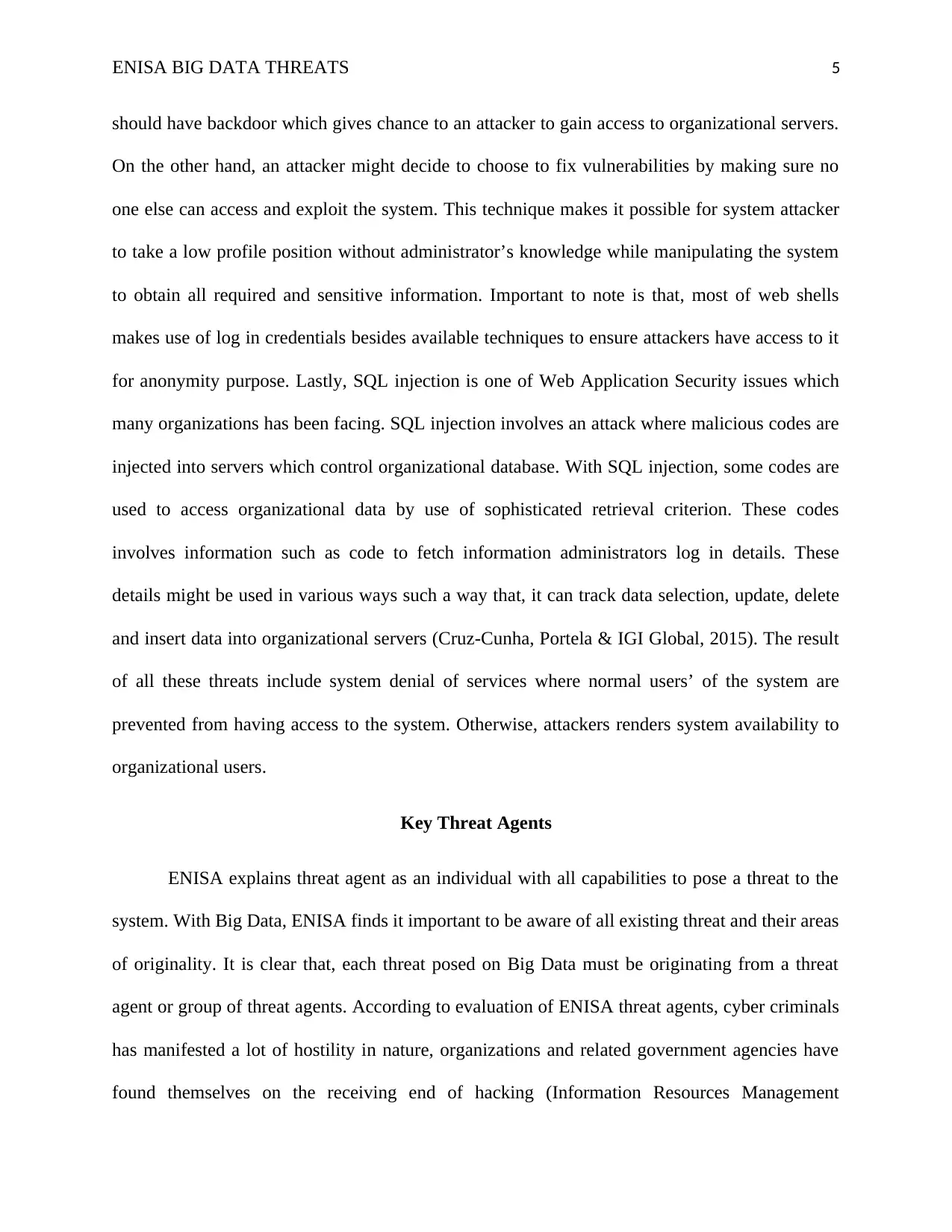
ENISA BIG DATA THREATS 5
should have backdoor which gives chance to an attacker to gain access to organizational servers.
On the other hand, an attacker might decide to choose to fix vulnerabilities by making sure no
one else can access and exploit the system. This technique makes it possible for system attacker
to take a low profile position without administrator’s knowledge while manipulating the system
to obtain all required and sensitive information. Important to note is that, most of web shells
makes use of log in credentials besides available techniques to ensure attackers have access to it
for anonymity purpose. Lastly, SQL injection is one of Web Application Security issues which
many organizations has been facing. SQL injection involves an attack where malicious codes are
injected into servers which control organizational database. With SQL injection, some codes are
used to access organizational data by use of sophisticated retrieval criterion. These codes
involves information such as code to fetch information administrators log in details. These
details might be used in various ways such a way that, it can track data selection, update, delete
and insert data into organizational servers (Cruz-Cunha, Portela & IGI Global, 2015). The result
of all these threats include system denial of services where normal users’ of the system are
prevented from having access to the system. Otherwise, attackers renders system availability to
organizational users.
Key Threat Agents
ENISA explains threat agent as an individual with all capabilities to pose a threat to the
system. With Big Data, ENISA finds it important to be aware of all existing threat and their areas
of originality. It is clear that, each threat posed on Big Data must be originating from a threat
agent or group of threat agents. According to evaluation of ENISA threat agents, cyber criminals
has manifested a lot of hostility in nature, organizations and related government agencies have
found themselves on the receiving end of hacking (Information Resources Management
should have backdoor which gives chance to an attacker to gain access to organizational servers.
On the other hand, an attacker might decide to choose to fix vulnerabilities by making sure no
one else can access and exploit the system. This technique makes it possible for system attacker
to take a low profile position without administrator’s knowledge while manipulating the system
to obtain all required and sensitive information. Important to note is that, most of web shells
makes use of log in credentials besides available techniques to ensure attackers have access to it
for anonymity purpose. Lastly, SQL injection is one of Web Application Security issues which
many organizations has been facing. SQL injection involves an attack where malicious codes are
injected into servers which control organizational database. With SQL injection, some codes are
used to access organizational data by use of sophisticated retrieval criterion. These codes
involves information such as code to fetch information administrators log in details. These
details might be used in various ways such a way that, it can track data selection, update, delete
and insert data into organizational servers (Cruz-Cunha, Portela & IGI Global, 2015). The result
of all these threats include system denial of services where normal users’ of the system are
prevented from having access to the system. Otherwise, attackers renders system availability to
organizational users.
Key Threat Agents
ENISA explains threat agent as an individual with all capabilities to pose a threat to the
system. With Big Data, ENISA finds it important to be aware of all existing threat and their areas
of originality. It is clear that, each threat posed on Big Data must be originating from a threat
agent or group of threat agents. According to evaluation of ENISA threat agents, cyber criminals
has manifested a lot of hostility in nature, organizations and related government agencies have
found themselves on the receiving end of hacking (Information Resources Management

ENISA BIG DATA THREATS 6
Association, 2017). Though ENISA has come up with policies that governs its member states on
the mode of operations regarding cyber security, cyber criminals has been quite diverse and
sophisticated so solve due to the nature of evolving technology. Origin of cyber criminals is
basically based on both local and international level. The main reason of coming up with ENISA
security strategy is to have one goal and unified security measures in solving cyber security
problems. Though these policies helps in mitigating cyber security lapses, this does not mean
there is complete ENISA strategy in solving cyber criminals’ problems. Lehto & Neittaanmäki
(2015) argues that, to minimize cyber criminals’ problem, some measures need to be taken in
order to minimize threats originating from cyber criminals. Some of the ways which can be used
to lower these risks include; setting up of policies that govern general access of information from
one country to the other. Since cyber criminals are rising up with alarming rate, it is important to
put up strict measures that each ENISA member state has to follow when handling cases related
to cyber security.
Similarly, with rise in cyber criminals, organizations from each ENISA member states
should educate member states on best cyber security strategies while protecting related data.
According to Akhgar & Brewster (2016), ENISA recommends use of data encryption so that if
hackers gains access to the system, data is of no use because they do not have decryption key.
When data is encrypted, even after hackers gain access to information system, data obtained
would be of no use to the attacker. To make sure data is well preserved, encryption method used
should be very strong to make it difficult decipher for security purposes. To make encryption
more effective, ENISA recommends all encryption keys to be managed by Chief Security Officer
(CSO). Additionally, other security measures includes educating all involved stakeholders on
their roles to protect organizational data. With rise in cyber criminals, data protection and
Association, 2017). Though ENISA has come up with policies that governs its member states on
the mode of operations regarding cyber security, cyber criminals has been quite diverse and
sophisticated so solve due to the nature of evolving technology. Origin of cyber criminals is
basically based on both local and international level. The main reason of coming up with ENISA
security strategy is to have one goal and unified security measures in solving cyber security
problems. Though these policies helps in mitigating cyber security lapses, this does not mean
there is complete ENISA strategy in solving cyber criminals’ problems. Lehto & Neittaanmäki
(2015) argues that, to minimize cyber criminals’ problem, some measures need to be taken in
order to minimize threats originating from cyber criminals. Some of the ways which can be used
to lower these risks include; setting up of policies that govern general access of information from
one country to the other. Since cyber criminals are rising up with alarming rate, it is important to
put up strict measures that each ENISA member state has to follow when handling cases related
to cyber security.
Similarly, with rise in cyber criminals, organizations from each ENISA member states
should educate member states on best cyber security strategies while protecting related data.
According to Akhgar & Brewster (2016), ENISA recommends use of data encryption so that if
hackers gains access to the system, data is of no use because they do not have decryption key.
When data is encrypted, even after hackers gain access to information system, data obtained
would be of no use to the attacker. To make sure data is well preserved, encryption method used
should be very strong to make it difficult decipher for security purposes. To make encryption
more effective, ENISA recommends all encryption keys to be managed by Chief Security Officer
(CSO). Additionally, other security measures includes educating all involved stakeholders on
their roles to protect organizational data. With rise in cyber criminals, data protection and
⊘ This is a preview!⊘
Do you want full access?
Subscribe today to unlock all pages.

Trusted by 1+ million students worldwide
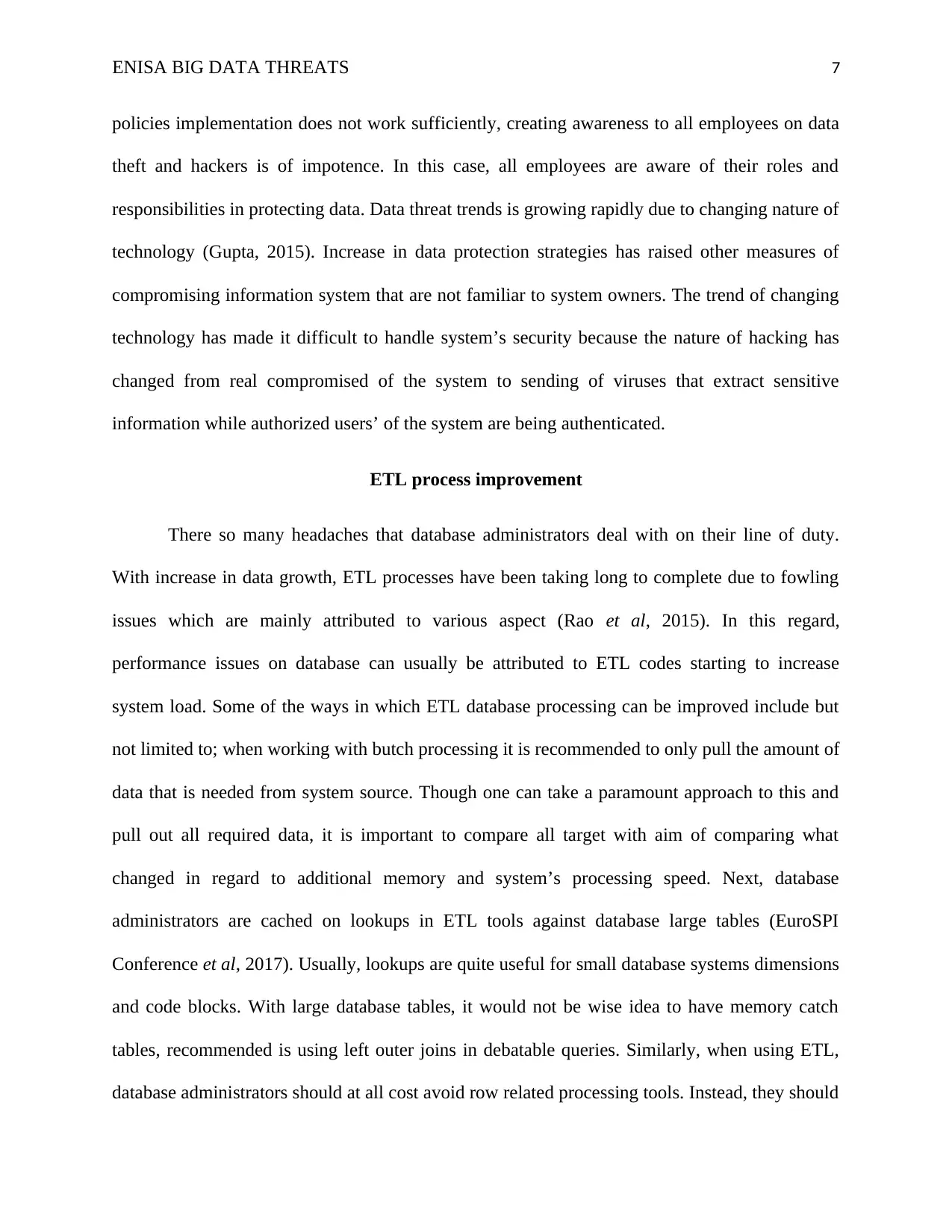
ENISA BIG DATA THREATS 7
policies implementation does not work sufficiently, creating awareness to all employees on data
theft and hackers is of impotence. In this case, all employees are aware of their roles and
responsibilities in protecting data. Data threat trends is growing rapidly due to changing nature of
technology (Gupta, 2015). Increase in data protection strategies has raised other measures of
compromising information system that are not familiar to system owners. The trend of changing
technology has made it difficult to handle system’s security because the nature of hacking has
changed from real compromised of the system to sending of viruses that extract sensitive
information while authorized users’ of the system are being authenticated.
ETL process improvement
There so many headaches that database administrators deal with on their line of duty.
With increase in data growth, ETL processes have been taking long to complete due to fowling
issues which are mainly attributed to various aspect (Rao et al, 2015). In this regard,
performance issues on database can usually be attributed to ETL codes starting to increase
system load. Some of the ways in which ETL database processing can be improved include but
not limited to; when working with butch processing it is recommended to only pull the amount of
data that is needed from system source. Though one can take a paramount approach to this and
pull out all required data, it is important to compare all target with aim of comparing what
changed in regard to additional memory and system’s processing speed. Next, database
administrators are cached on lookups in ETL tools against database large tables (EuroSPI
Conference et al, 2017). Usually, lookups are quite useful for small database systems dimensions
and code blocks. With large database tables, it would not be wise idea to have memory catch
tables, recommended is using left outer joins in debatable queries. Similarly, when using ETL,
database administrators should at all cost avoid row related processing tools. Instead, they should
policies implementation does not work sufficiently, creating awareness to all employees on data
theft and hackers is of impotence. In this case, all employees are aware of their roles and
responsibilities in protecting data. Data threat trends is growing rapidly due to changing nature of
technology (Gupta, 2015). Increase in data protection strategies has raised other measures of
compromising information system that are not familiar to system owners. The trend of changing
technology has made it difficult to handle system’s security because the nature of hacking has
changed from real compromised of the system to sending of viruses that extract sensitive
information while authorized users’ of the system are being authenticated.
ETL process improvement
There so many headaches that database administrators deal with on their line of duty.
With increase in data growth, ETL processes have been taking long to complete due to fowling
issues which are mainly attributed to various aspect (Rao et al, 2015). In this regard,
performance issues on database can usually be attributed to ETL codes starting to increase
system load. Some of the ways in which ETL database processing can be improved include but
not limited to; when working with butch processing it is recommended to only pull the amount of
data that is needed from system source. Though one can take a paramount approach to this and
pull out all required data, it is important to compare all target with aim of comparing what
changed in regard to additional memory and system’s processing speed. Next, database
administrators are cached on lookups in ETL tools against database large tables (EuroSPI
Conference et al, 2017). Usually, lookups are quite useful for small database systems dimensions
and code blocks. With large database tables, it would not be wise idea to have memory catch
tables, recommended is using left outer joins in debatable queries. Similarly, when using ETL,
database administrators should at all cost avoid row related processing tools. Instead, they should
Paraphrase This Document
Need a fresh take? Get an instant paraphrase of this document with our AI Paraphraser

ENISA BIG DATA THREATS 8
turn to an alternative of bulk loading available from ETL tools. This is because, it is highly
recommended for use in large database scenarios. Moreover, in sources that make use of
database, it is advisable to upload database table joins to specific applications. There are chances
that, individual database is able to do inner joins more efficiently with use of ETL tools (Fauzi,
2012). Additionally, one should not make use of courser when working with ETL codes because
courser have their own use which should be regularly scheduled in ETL processes. ETL is
usually rewritten using logic codes. In this regard, ETL logic scheduling is meant to make sure
there is full utilization of so many parallel threads for maximum utilization of system
application.
Consequently, there is a step by step at the end of the job processes to help in rebuilding
database indexes in any of reporting tables. This makes all indexes created on data tables are
optional and not for reports only but should include ETL processes downstream that are related
to subject tables. Further, it would be quite hectic for an administrator to fail to upgrade and turn
on Auto Statistics updates. In cases where subject database does not make use of Auto Statistics
Update, it is important to turn it off for security purposes El (Akkaoui et al, 2011). Still, one
should not forget to limit the number of CTEs and its related table joins and check whether data
staging into data tables may be of any value to ETL processes. Finally, when using stored
procedures in ETL operational processing, it is wise to copy all related input parameters into
stored procedures. This is usually done because mostly, SQL has some problems of suffering
from sniffing of parameters. To solve such problems, use of internal variable helps in mitigating
these risks.
ENISA current state of IT security
turn to an alternative of bulk loading available from ETL tools. This is because, it is highly
recommended for use in large database scenarios. Moreover, in sources that make use of
database, it is advisable to upload database table joins to specific applications. There are chances
that, individual database is able to do inner joins more efficiently with use of ETL tools (Fauzi,
2012). Additionally, one should not make use of courser when working with ETL codes because
courser have their own use which should be regularly scheduled in ETL processes. ETL is
usually rewritten using logic codes. In this regard, ETL logic scheduling is meant to make sure
there is full utilization of so many parallel threads for maximum utilization of system
application.
Consequently, there is a step by step at the end of the job processes to help in rebuilding
database indexes in any of reporting tables. This makes all indexes created on data tables are
optional and not for reports only but should include ETL processes downstream that are related
to subject tables. Further, it would be quite hectic for an administrator to fail to upgrade and turn
on Auto Statistics updates. In cases where subject database does not make use of Auto Statistics
Update, it is important to turn it off for security purposes El (Akkaoui et al, 2011). Still, one
should not forget to limit the number of CTEs and its related table joins and check whether data
staging into data tables may be of any value to ETL processes. Finally, when using stored
procedures in ETL operational processing, it is wise to copy all related input parameters into
stored procedures. This is usually done because mostly, SQL has some problems of suffering
from sniffing of parameters. To solve such problems, use of internal variable helps in mitigating
these risks.
ENISA current state of IT security
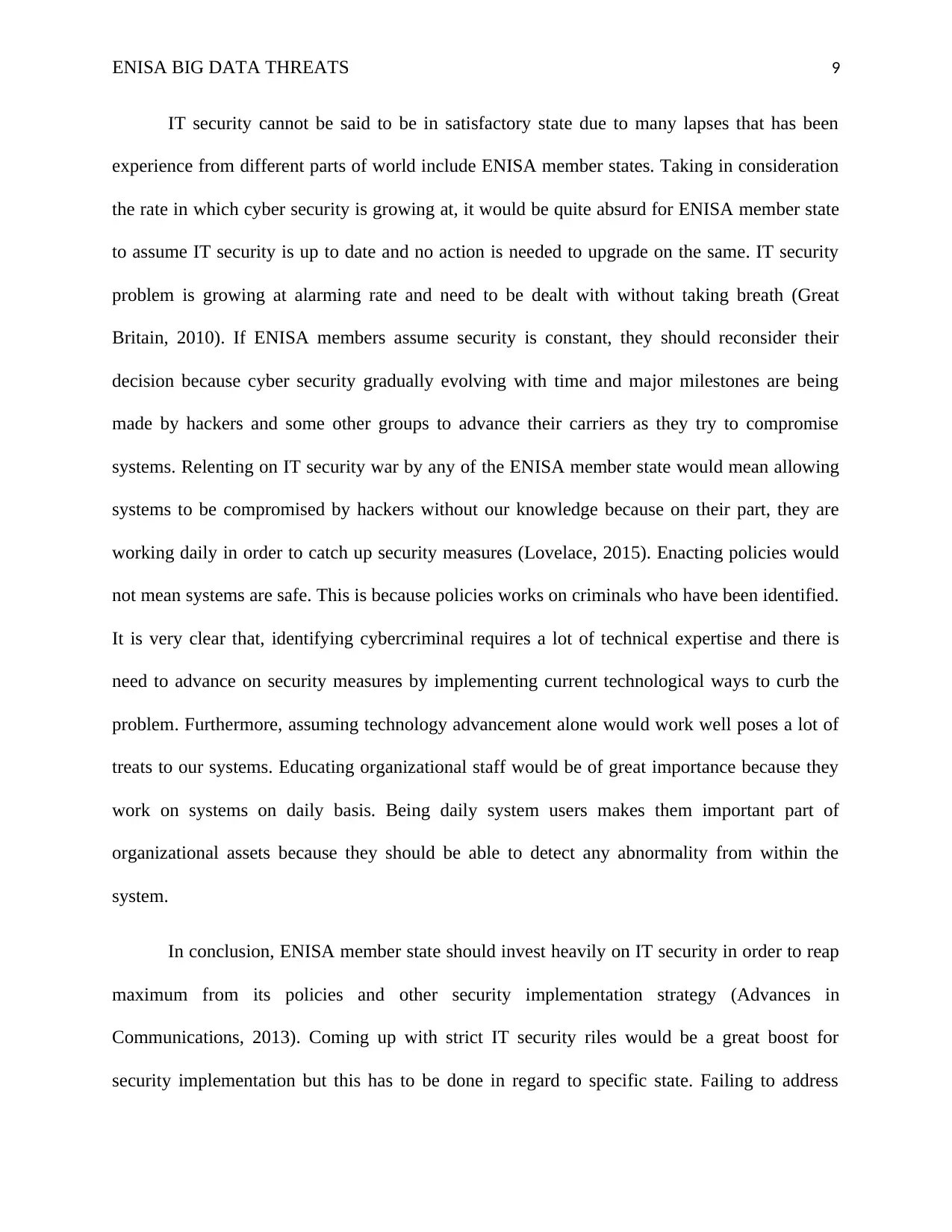
ENISA BIG DATA THREATS 9
IT security cannot be said to be in satisfactory state due to many lapses that has been
experience from different parts of world include ENISA member states. Taking in consideration
the rate in which cyber security is growing at, it would be quite absurd for ENISA member state
to assume IT security is up to date and no action is needed to upgrade on the same. IT security
problem is growing at alarming rate and need to be dealt with without taking breath (Great
Britain, 2010). If ENISA members assume security is constant, they should reconsider their
decision because cyber security gradually evolving with time and major milestones are being
made by hackers and some other groups to advance their carriers as they try to compromise
systems. Relenting on IT security war by any of the ENISA member state would mean allowing
systems to be compromised by hackers without our knowledge because on their part, they are
working daily in order to catch up security measures (Lovelace, 2015). Enacting policies would
not mean systems are safe. This is because policies works on criminals who have been identified.
It is very clear that, identifying cybercriminal requires a lot of technical expertise and there is
need to advance on security measures by implementing current technological ways to curb the
problem. Furthermore, assuming technology advancement alone would work well poses a lot of
treats to our systems. Educating organizational staff would be of great importance because they
work on systems on daily basis. Being daily system users makes them important part of
organizational assets because they should be able to detect any abnormality from within the
system.
In conclusion, ENISA member state should invest heavily on IT security in order to reap
maximum from its policies and other security implementation strategy (Advances in
Communications, 2013). Coming up with strict IT security riles would be a great boost for
security implementation but this has to be done in regard to specific state. Failing to address
IT security cannot be said to be in satisfactory state due to many lapses that has been
experience from different parts of world include ENISA member states. Taking in consideration
the rate in which cyber security is growing at, it would be quite absurd for ENISA member state
to assume IT security is up to date and no action is needed to upgrade on the same. IT security
problem is growing at alarming rate and need to be dealt with without taking breath (Great
Britain, 2010). If ENISA members assume security is constant, they should reconsider their
decision because cyber security gradually evolving with time and major milestones are being
made by hackers and some other groups to advance their carriers as they try to compromise
systems. Relenting on IT security war by any of the ENISA member state would mean allowing
systems to be compromised by hackers without our knowledge because on their part, they are
working daily in order to catch up security measures (Lovelace, 2015). Enacting policies would
not mean systems are safe. This is because policies works on criminals who have been identified.
It is very clear that, identifying cybercriminal requires a lot of technical expertise and there is
need to advance on security measures by implementing current technological ways to curb the
problem. Furthermore, assuming technology advancement alone would work well poses a lot of
treats to our systems. Educating organizational staff would be of great importance because they
work on systems on daily basis. Being daily system users makes them important part of
organizational assets because they should be able to detect any abnormality from within the
system.
In conclusion, ENISA member state should invest heavily on IT security in order to reap
maximum from its policies and other security implementation strategy (Advances in
Communications, 2013). Coming up with strict IT security riles would be a great boost for
security implementation but this has to be done in regard to specific state. Failing to address
⊘ This is a preview!⊘
Do you want full access?
Subscribe today to unlock all pages.

Trusted by 1+ million students worldwide

ENISA BIG DATA THREATS 10
specific member state problem and comparing it with all involved parties need would render al
processes ineffective. Addressing each member state problem would give an opportunity to
compare existing challenges in cyber security so that all set out programs would be quite diverse
to ensure there is commonality in solving the problem. Joint effort is the key strategy in fighting
IT security lapses and if members loose unity, it will be a total fail that no one member state can
solve by itself. Having analyzed all security lapses and solutions available, it is now clear that, a
lot of research is need from ENISA member state to ensure there is common goal in fighting
security lapses in technology (SmartGridSec (Workshop) & In Cuellar, 2014). This should
involve; developing common agenda in fighting IT security lapses, creating a common team of
IT experts in cyber security to be on constant access and test of security lapses that might be
thriving into the market. Creating awareness to all member states on rules and their
responsibilities in solving cyber security problems.
References
Advances in Communications. (2013). Plymouth: University of Plymouth Press.
Akhgar, B., & Brewster, B. (2016). Combatting cybercrime and cyberterrorism: Challenges,
trends and priorities.
Akhgar, B., & In Brewster, B. (2016). Combatting cybercrime and cyberterrorism: Challenges,
trends and priorities.
Axelrod, C. W. (2013). Engineering safe and secure software systems. Norwood, MA: Artech
House.
Cruz-Cunha, M. M., In Portela, I. M., & IGI Global. (2015). Handbook of research on digital
crime, cyberspace security, and information assurance.
specific member state problem and comparing it with all involved parties need would render al
processes ineffective. Addressing each member state problem would give an opportunity to
compare existing challenges in cyber security so that all set out programs would be quite diverse
to ensure there is commonality in solving the problem. Joint effort is the key strategy in fighting
IT security lapses and if members loose unity, it will be a total fail that no one member state can
solve by itself. Having analyzed all security lapses and solutions available, it is now clear that, a
lot of research is need from ENISA member state to ensure there is common goal in fighting
security lapses in technology (SmartGridSec (Workshop) & In Cuellar, 2014). This should
involve; developing common agenda in fighting IT security lapses, creating a common team of
IT experts in cyber security to be on constant access and test of security lapses that might be
thriving into the market. Creating awareness to all member states on rules and their
responsibilities in solving cyber security problems.
References
Advances in Communications. (2013). Plymouth: University of Plymouth Press.
Akhgar, B., & Brewster, B. (2016). Combatting cybercrime and cyberterrorism: Challenges,
trends and priorities.
Akhgar, B., & In Brewster, B. (2016). Combatting cybercrime and cyberterrorism: Challenges,
trends and priorities.
Axelrod, C. W. (2013). Engineering safe and secure software systems. Norwood, MA: Artech
House.
Cruz-Cunha, M. M., In Portela, I. M., & IGI Global. (2015). Handbook of research on digital
crime, cyberspace security, and information assurance.
Paraphrase This Document
Need a fresh take? Get an instant paraphrase of this document with our AI Paraphraser
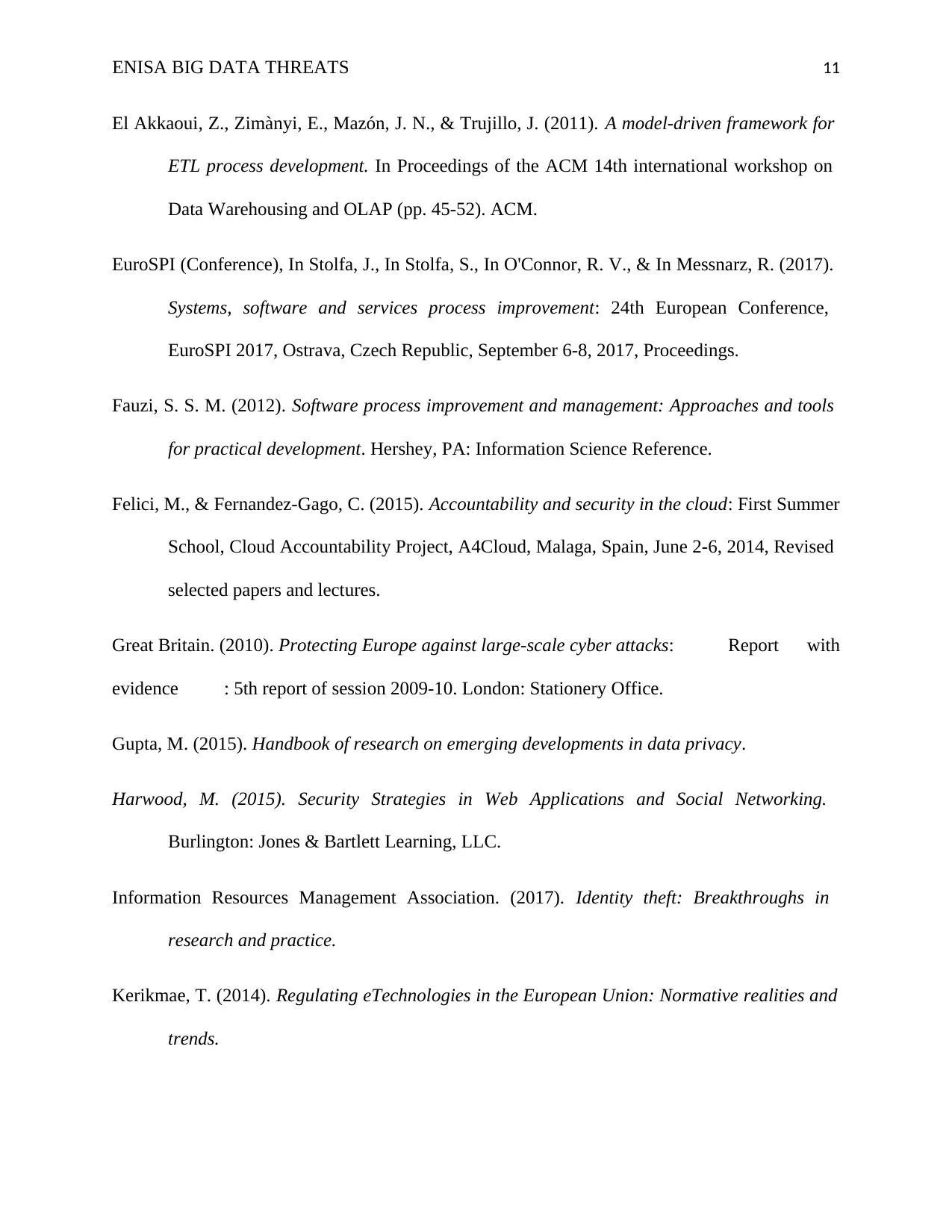
ENISA BIG DATA THREATS 11
El Akkaoui, Z., Zimànyi, E., Mazón, J. N., & Trujillo, J. (2011). A model-driven framework for
ETL process development. In Proceedings of the ACM 14th international workshop on
Data Warehousing and OLAP (pp. 45-52). ACM.
EuroSPI (Conference), In Stolfa, J., In Stolfa, S., In O'Connor, R. V., & In Messnarz, R. (2017).
Systems, software and services process improvement: 24th European Conference,
EuroSPI 2017, Ostrava, Czech Republic, September 6-8, 2017, Proceedings.
Fauzi, S. S. M. (2012). Software process improvement and management: Approaches and tools
for practical development. Hershey, PA: Information Science Reference.
Felici, M., & Fernandez-Gago, C. (2015). Accountability and security in the cloud: First Summer
School, Cloud Accountability Project, A4Cloud, Malaga, Spain, June 2-6, 2014, Revised
selected papers and lectures.
Great Britain. (2010). Protecting Europe against large-scale cyber attacks: Report with
evidence : 5th report of session 2009-10. London: Stationery Office.
Gupta, M. (2015). Handbook of research on emerging developments in data privacy.
Harwood, M. (2015). Security Strategies in Web Applications and Social Networking.
Burlington: Jones & Bartlett Learning, LLC.
Information Resources Management Association. (2017). Identity theft: Breakthroughs in
research and practice.
Kerikmae, T. (2014). Regulating eTechnologies in the European Union: Normative realities and
trends.
El Akkaoui, Z., Zimànyi, E., Mazón, J. N., & Trujillo, J. (2011). A model-driven framework for
ETL process development. In Proceedings of the ACM 14th international workshop on
Data Warehousing and OLAP (pp. 45-52). ACM.
EuroSPI (Conference), In Stolfa, J., In Stolfa, S., In O'Connor, R. V., & In Messnarz, R. (2017).
Systems, software and services process improvement: 24th European Conference,
EuroSPI 2017, Ostrava, Czech Republic, September 6-8, 2017, Proceedings.
Fauzi, S. S. M. (2012). Software process improvement and management: Approaches and tools
for practical development. Hershey, PA: Information Science Reference.
Felici, M., & Fernandez-Gago, C. (2015). Accountability and security in the cloud: First Summer
School, Cloud Accountability Project, A4Cloud, Malaga, Spain, June 2-6, 2014, Revised
selected papers and lectures.
Great Britain. (2010). Protecting Europe against large-scale cyber attacks: Report with
evidence : 5th report of session 2009-10. London: Stationery Office.
Gupta, M. (2015). Handbook of research on emerging developments in data privacy.
Harwood, M. (2015). Security Strategies in Web Applications and Social Networking.
Burlington: Jones & Bartlett Learning, LLC.
Information Resources Management Association. (2017). Identity theft: Breakthroughs in
research and practice.
Kerikmae, T. (2014). Regulating eTechnologies in the European Union: Normative realities and
trends.
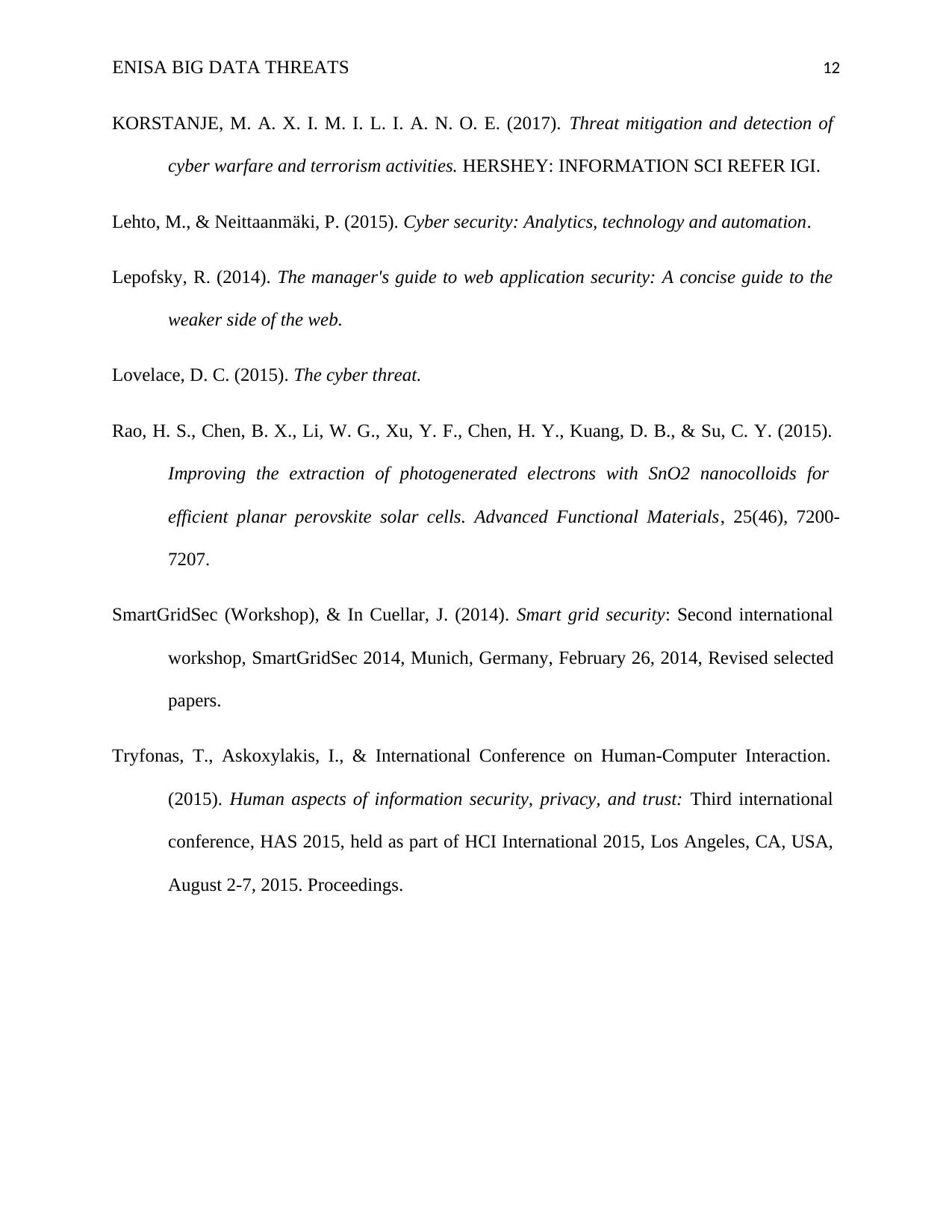
ENISA BIG DATA THREATS 12
KORSTANJE, M. A. X. I. M. I. L. I. A. N. O. E. (2017). Threat mitigation and detection of
cyber warfare and terrorism activities. HERSHEY: INFORMATION SCI REFER IGI.
Lehto, M., & Neittaanmäki, P. (2015). Cyber security: Analytics, technology and automation.
Lepofsky, R. (2014). The manager's guide to web application security: A concise guide to the
weaker side of the web.
Lovelace, D. C. (2015). The cyber threat.
Rao, H. S., Chen, B. X., Li, W. G., Xu, Y. F., Chen, H. Y., Kuang, D. B., & Su, C. Y. (2015).
Improving the extraction of photogenerated electrons with SnO2 nanocolloids for
efficient planar perovskite solar cells. Advanced Functional Materials, 25(46), 7200-
7207.
SmartGridSec (Workshop), & In Cuellar, J. (2014). Smart grid security: Second international
workshop, SmartGridSec 2014, Munich, Germany, February 26, 2014, Revised selected
papers.
Tryfonas, T., Askoxylakis, I., & International Conference on Human-Computer Interaction.
(2015). Human aspects of information security, privacy, and trust: Third international
conference, HAS 2015, held as part of HCI International 2015, Los Angeles, CA, USA,
August 2-7, 2015. Proceedings.
KORSTANJE, M. A. X. I. M. I. L. I. A. N. O. E. (2017). Threat mitigation and detection of
cyber warfare and terrorism activities. HERSHEY: INFORMATION SCI REFER IGI.
Lehto, M., & Neittaanmäki, P. (2015). Cyber security: Analytics, technology and automation.
Lepofsky, R. (2014). The manager's guide to web application security: A concise guide to the
weaker side of the web.
Lovelace, D. C. (2015). The cyber threat.
Rao, H. S., Chen, B. X., Li, W. G., Xu, Y. F., Chen, H. Y., Kuang, D. B., & Su, C. Y. (2015).
Improving the extraction of photogenerated electrons with SnO2 nanocolloids for
efficient planar perovskite solar cells. Advanced Functional Materials, 25(46), 7200-
7207.
SmartGridSec (Workshop), & In Cuellar, J. (2014). Smart grid security: Second international
workshop, SmartGridSec 2014, Munich, Germany, February 26, 2014, Revised selected
papers.
Tryfonas, T., Askoxylakis, I., & International Conference on Human-Computer Interaction.
(2015). Human aspects of information security, privacy, and trust: Third international
conference, HAS 2015, held as part of HCI International 2015, Los Angeles, CA, USA,
August 2-7, 2015. Proceedings.
⊘ This is a preview!⊘
Do you want full access?
Subscribe today to unlock all pages.

Trusted by 1+ million students worldwide
1 out of 12
Related Documents
Your All-in-One AI-Powered Toolkit for Academic Success.
+13062052269
info@desklib.com
Available 24*7 on WhatsApp / Email
![[object Object]](/_next/static/media/star-bottom.7253800d.svg)
Unlock your academic potential
Copyright © 2020–2025 A2Z Services. All Rights Reserved. Developed and managed by ZUCOL.





